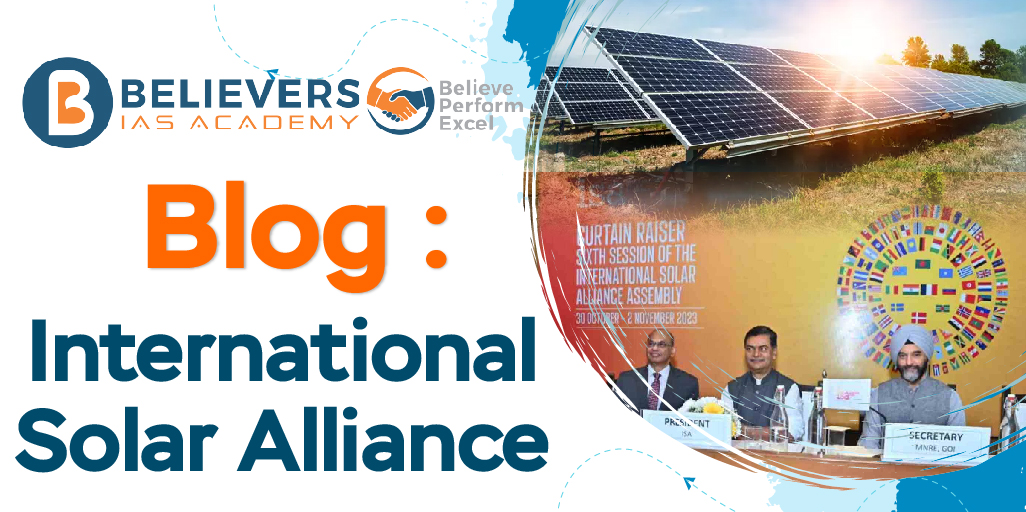International Solar Alliance
- The International Solar Alliance (ISA) is an international organization that works to increase the use of solar energy technologies. The International Solar Alliance (ISA) seeks to advance solar energy as a sustainable means of achieving carbon neutrality while also enhancing global energy access and security.
- The ISA was founded in the year 2015. Its 121 members are all entirely or partially between the Tropics of Cancer and Capricorn and are endowed with abundant solar resources. “Let us together make the sun brighter” is the ISA’s motto.
- The National Institute of Solar Energy (NISE) in Gwalpahari, Gurugram, India, is the base of operations for the International Solar Alliance. French President François Hollande and Prime Minister Narendra Modi laid the foundation stone for the headquarters in January 2016.
What are the objectives of the ISA?
- Promotion of Solar Energy: Encouraging the efficient use of solar energy is the ISA’s main goal. The alliance promotes the creation and use of solar technology and projects to use the sun’s energy for a variety of purposes.
- Access to Solar Energy: The International Solar Alliance (ISA) seeks to improve everyone’s ability to obtain inexpensive, sustainable solar energy, with a focus on sun-loving nations situated between the Tropics of Cancer and Capricorn. Providing electricity to isolated and off-grid places is part of this.
- Building Capacity: The International Solar Alliance (ISA) strives to increase member nations’ solar energy capacity. This includes exchanging best practices, technology, and knowledge about the production, distribution, and use of solar energy.
- Research and Development: In the area of solar energy, the alliance supports research and development. This involves making advancements in solar technology, energy storage systems, and associated infrastructure.
- Investment Mobilization: The goal of the ISA is to raise a sizable sum of money for solar energy projects. It aims to draw investments from the public and private sectors to help with the construction of solar energy infrastructure.
- Advocacy for Policies: The alliance is in favour of laws and rules that promote solar energy use and foster an atmosphere that is conducive to investment in the industry.
- International Cooperation: To solve shared concerns about solar energy, climate change, and sustainable development, the International Solar Alliance (ISA) promotes international cooperation and collaboration among member countries and other stakeholders.
- Decrease in Greenhouse Gas Emissions: The ISA helps to reduce greenhouse gas emissions, which is crucial for lessening the effects of climate change, by encouraging the use of solar energy.
- Energy Security: By diversifying energy sources and lowering reliance on fossil fuels, which are vulnerable to price swings and geopolitical unrest, solar energy can improve energy security.
- Economic Development: By generating employment opportunities and supporting the expansion of the renewable energy industry, the use of solar energy can promote economic development.
What is the geographical importance of the place?
- Abundant Solar Energy: Because of its closeness to the equator, the area between the Tropics of Cancer and Capricorn has year-round, plentiful solar radiation. Because of this, it has a great potential for solar energy and is therefore ideally situated for solar power generation.
- Direct sunshine: More direct and intense sunshine can be found in this tropical region when the sun appears almost above. It is ideal for producing solar energy efficiently because of its direct exposure to the sun’s rays.
- Optimal Sun Conditions: This region’s countries have comparatively little cloud cover and fewer obstacles that could obscure the sun’s beams. It’s a great place to generate solar energy because of the ideal solar conditions.
- Energy Access: Many tropical nations, especially those in Africa and some regions of Asia, struggle with energy access issues, with a sizable section of their populations living without access to power. In isolated and off-grid locations, solar energy can assist in resolving these problems with electricity access.
- Mitigation of Climate Change: The ISA’s emphasis on the tropics is noteworthy when considering climate change. The partnership helps to mitigate the consequences of climate change by lowering greenhouse gas emissions and encouraging the use of solar energy in certain areas.
- Economic and Social Development: In the tropics, solar energy projects can boost employment growth, raise living standards, and promote economic development. For economic, healthcare, and educational purposes, having access to power is essential, and solar energy can significantly raise living standards in these areas.
- Global Impact: A sizeable fraction of the world’s population lives in tropical regions. Encouraging solar energy in this area helps mitigate global warming by lowering carbon emissions and supporting global initiatives to address the issue.
- Cooperation and Solidarity: By concentrating on tropical nations, the ISA promotes collaboration and solidarity among these states to tackle shared energy and environmental issues.
Who are the members of this alliance?
- The International Solar Alliance is an inter-governmental organization based on a treaty.
- The framework agreement for the International Solar Alliance was opened for signatures in November 2016 in Marrakech, Morocco, during the Marrakech Climate Change Conference (COP 22).
- Sixteen countries signed the Agreement on the first day, including India, Brazil, the Democratic Republic of Congo, the Dominican Republic, and others.
- By November 17, additional countries like Guinea Bissau, Fiji, and France had also signed the agreement.
- On November 6, 2017, Guinea’s Foreign Minister submitted Guinea’s Instrument of Accession to the International Solar Alliance during a meeting with India’s External Affairs Minister. Vanuatu and Liberia also signed the agreement.
- A total of 107 more countries, including the United States, Japan, France, Brazil, and India, joined the agreement.
- The initiative began with the establishment of the InSPA (International Agency for Solar Policy & Application) on November 30, 2015.
What are the initiatives under International Solar Alliances?
- One Sun, One World, One Infrastructure (OSOWOG): To enable the sharing of solar energy resources, this program aims to establish a global electrical infrastructure connecting nations with abundant solar energy. It aims to create a single worldwide grid that will allow solar energy to be traded between different parts of the world, guaranteeing a steady supply of clean energy.
- Global Solar Atlas: The International Solar Alliance (ISA) and the World Bank have collaborated to introduce the Global Solar Atlas, an online resource that offers data on the potential for solar energy in every area around the globe. It assists governments, financiers, and developers in locating appropriate locations for the production of solar energy.
- Scalable and Reasonably Priced Finance: The ISA is striving to attract capital and offer reasonably priced finance for solar energy initiatives. The goal of this project is to lower the cost barriers that prevent the widespread use of solar energy technology, particularly in poor nations.
- Expanding the usage of Solar Mini-Grids: The goal of this initiative is to increase the usage of solar mini-grids to provide electricity to isolated and off-grid locations. For towns without access to the main grid, solar mini-grids are an affordable way to provide consistent power.
- Solar agriculture: The International Solar Alliance (ISA) promotes the use of solar energy in agriculture, including irrigation systems and solar-powered water pumps. The objective of this effort is to decrease farming’s carbon footprint and increase agricultural output.
What difficulties does the International Solar Alliance face?
- A clear economic strategy for achieving grid parity with solar electricity is lacking.
- The main obstacles to reaching the objective of energy security are the availability of energy technologies and the necessary money.
- balancing the divergent interests of local and international rivals.
- Discussions concerning commercial tactics could arise, such as where to get the parts and equipment needed to make solar panels and other necessary accessories.




